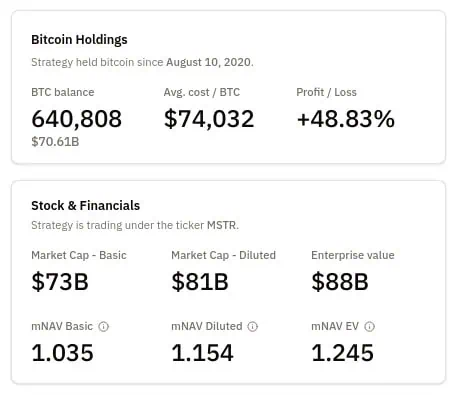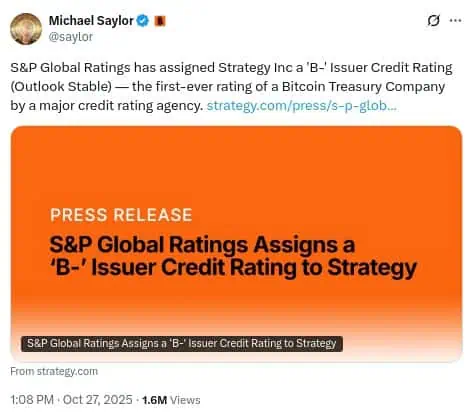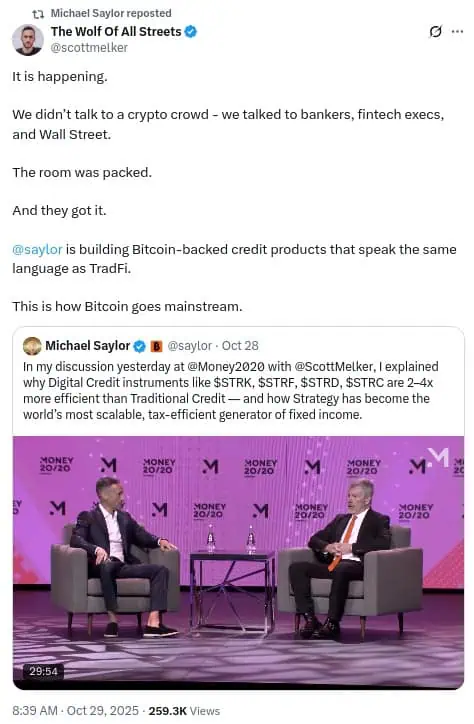
Strategy Inc. reports $2.800 billion in quarterly profits thanks to Bitcoin, solidifying its financial model based on digital assets and structured credit.
The company led by Michael Saylor has once again set a milestone at the intersection of traditional finance and digital assets. At the close of the third quarter, Strategy reported net income of $2.800 billion, driven by the appreciation of its Bitcoin holdings, which now reach... 640.808 BTC.
Experts say this result not only exceeds market expectations, but also confirms Strategy's consolidation as a structural player in the global financial ecosystem, thanks to its model of intensive adoption of Bitcoin as a treasury asset and basis for credit products.
This strategy generates billions. Trade BTC hereBitcoin as a financial engine: the bold vision behind a trillion-dollar strategy
Bitcoin's year-to-date performance has been 26%, generating $12.900 billion in profit for Strategy, bringing it closer to its annual target of $20.000 billion. With an average purchase price of $74.032 per coin and a price close to $110.600 as of October 24, the company's accumulation strategy has proven profitable in both accounting and narrative terms. The company has capitalized 116.555 BTC in unrealized gains, which has raised the value of its reserves to $70.000 billion, according to market data.
Beyond these numbers, Saylor has evolved his discourse towards a more structural vision for build a Bitcoin balance of one trillion dollars. In interviews In recent years, Saylor has outlined a plan to transform credit markets using Bitcoin-backed instruments with yields between 8% and 12,5%, overcollateralization, and tax efficiency. According to Bloomberg, with this architecture, Saylor seeks to position Bitcoin as a viable alternative to traditional corporate debt, especially in low-yield markets such as Europe and Japan.

The evolution of Bitcoin in the global financial market
Strategy's narrative isn't limited to accumulating Bitcoin as a store of value. Saylor projects a gradual integration of the cryptocurrency into corporate, banking, and sovereign balance sheets. His vision points to a reconfiguration of stock market indices, which could become indirect vehicles for exposure to BTC. In this context, technology companies with robust balance sheets—like Apple or Google—could channel capital into the digital economy, accelerating Bitcoin's legitimization as a structural asset.
The recent qualification Strategy's credit rating by S&P Global Ratings This reinforces this thesis. On October 27, the agency assigned a grade of “B-” With a stable outlook, this rating recognizes for the first time Bitcoin's role as legitimate collateral in a corporate debt model. Although considered speculative, it marks a turning point: Bitcoin has formally entered the analytical landscape of mainstream finance, alongside sovereign bonds and commodity-backed loans.

According to internal estimates, this recognition could unlock $130 billion in institutional capital. S&P's methodology, however, continues to view Bitcoin as a source of volatility rather than capital. It cites the asset's dependence, low market capitalization, and limited dollar liquidity as risk factors. But voices within the crypto sector, such as Jeff Park of ProCap BTC, challenge this assessment, arguing that Bitcoin's liquidity—instantly convertible without intermediaries—surpasses that of many traditional corporate reserves.
Bitcoin, the financial backbone: Bit2Me gives you accessBitcoin's strategy and financial language
During the Money20/20 event, Michael Saylor made it clear that Bitcoin is no longer just a digital store of value or a long-term investment. Speaking with Scott Melker to a room full of Wall Street executives, bankers, and fintech leaders, Saylor presented a concrete vision: Bitcoin is entering the heart of traditional finance, not as an alternative, but as a foundation for building products that speak the same language as conventional markets.
Strategy, the company he leads, has gone from being a pioneer in Bitcoin accumulation to becoming what he describes as the world's most efficient fixed income generator. How? Through a series of digital credit instruments designed to offer returns two to four times higher than those of traditional credit, Saylor explained that these products are not only backed by Bitcoin, but are structured to be fiscally efficient, scalable and understandable for the conventional financial system.

Additionally, Saylor explained These instruments allow Strategy to operate with a different logic: instead of relying on fiduciary debt, the company Use Bitcoin as collateral to issue creditThis not only reduces operating costs but also allows for higher returns without compromising stability. In their words, the model is safer than many forms of corporate debt and more profitable for investors.
Start your smart BTC accumulation on Bit2MeThe backbone of a new financial architecture
Strategy's performance in the third quarter of 2025 reflects more than just an accounting profit. It represents the consolidation of a model that uses Bitcoin as the backbone of a new financial architecture. With a vision that combines accumulation, structured credit, and institutional storytelling, the firm led by Michael Saylor has positioned itself as a financial giant in the digital ecosystem.
The S&P rating, reported earnings, and expansion of BTC-backed products highlight how Bitcoin has moved beyond being a fringe asset and become an integral part of the global financial system. In this context, Strategy is not only accumulating capital but also structural influence. Its model is ushering in a new era in the relationship between digital assets and traditional finance.

Basic Bitcoin Course
Basic levelStart from scratch in Bitcoin in a clear, easy, safe and quick way. This course is specially designed for beginners practically know nothing about Bitcoin.



